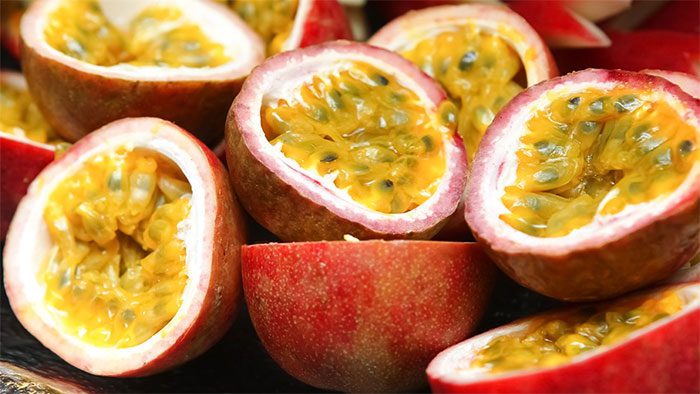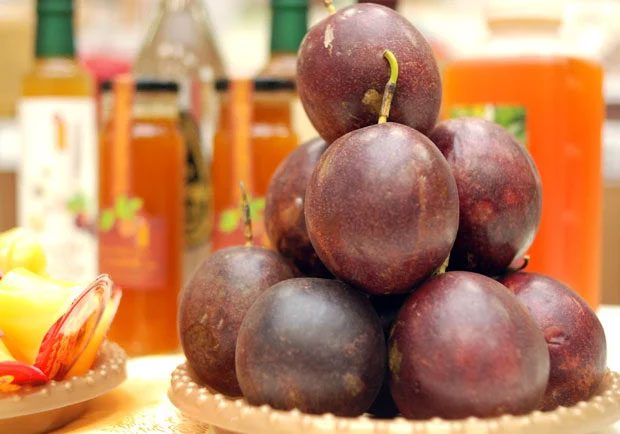In addition to the pulp of passion fruit, both the skin and seeds also contain numerous benefits that are often overlooked.
Amazing Benefits of Passion Fruit
Passion fruit, typically purple-skinned with yellow pulp and a sweet-sour flavor, emits a captivating aroma. According to renowned nutritionist Gao Minmin from Taiwan, many people consume passion fruit for its delicious taste and refreshing qualities, often neglecting its health and beauty benefits. In reality, this fruit is highly nutritious, rich in fiber, protein, carbohydrates, iron, copper, calcium, potassium, magnesium, vitamin A, vitamin B2, vitamin B3, and especially high in vitamin C.
Benefits of Passion Fruit
The passion fruit contains numerous black seeds, each surrounded by a thin, sour membrane. When the fruit ripens, the flesh and outer membrane release esters that emit a distinctive aroma loved by many.
However, most people typically only consume the pulp, discarding the seeds and skin without realizing that these parts also contain many health-promoting nutrients.
1. Pulp of Passion Fruit

Passion fruit is rich in nutrients, especially vitamins.
Nutritionist Du Chu Thanh notes that passion fruit is high in nutrients, particularly vitamins such as Vitamin A, C, carotenoids, and phytochemicals that help stabilize the nervous system, support sleep, improve anemia, and lower blood pressure.
Additionally, passion fruit contains a significant amount of fiber, which aids in smooth bowel movements. Mixing passion fruit with about 800-1000ml of warm water can also help reduce edema and support digestion.
2. Skin of Passion Fruit
Furthermore, Du Chu Thanh adds that the white skin of passion fruit is rich in pectin and antioxidants. Numerous studies have shown that the skin of passion fruit may help improve asthma, osteoarthritis, and pain from arthritis.
The skin can be used to make jam or dried and brewed as tea with other herbs.
3. Seeds of Passion Fruit
Crushed passion fruit seeds contain polyphenols that protect the cardiovascular system and combat aging by reducing free radicals that damage cells and preventing various degenerative diseases. Additionally, passion fruit seeds can prevent skin damage from ultraviolet rays and limit wrinkles.
Moreover, piceatannol is another compound that helps prevent disease and supports heart health. It is recommended to blend passion fruit seeds with the pulp to create salad dressings or juices with other fruits.

Crushed passion fruit seeds contain polyphenols that protect the cardiovascular system.
4. Beauty Benefits of Passion Fruit
In addition to its valuable medicinal properties mentioned above, passion fruit also offers numerous beauty benefits.
Vitamins A, C, and B2, as well as carotene in passion fruit, are excellent for skin beauty. They help moisturize and cleanse the skin, reduce acne, lighten skin tone, decrease dark spots, diminish wrinkles, and slow down skin cell aging. Additionally, passion fruit contains citric acid that helps remove dirt, oil, and dead skin cells, while tightening pores. It also enhances iron levels, promoting healthy, radiant skin.
Passion fruit is also beneficial for detoxifying and cleansing the body. Drinking passion fruit juice not only detoxifies the skin but also boosts metabolism, reduces visceral fat, and aids in weight loss. Eating fresh passion fruit or drinking its juice can also provide iron and other minerals that strengthen hair and nails.
It is important to note that passion fruit contains a small amount of a toxin called cyanogenic glycoside. This toxin is mostly concentrated in the skin and the unripe pulp of the fruit. To avoid poisoning or allergies, it is best to only eat fully ripe passion fruit and to avoid consuming the skin or unripe pulp.
Precautions When Eating Passion Fruit
Nutritionist Trịnh Hân Nghi advises that despite its many benefits, adults should limit themselves to eating no more than 2-3 passion fruits per day, as excessive consumption can burden the body. Additionally, the acid content in passion fruit is relatively high, and eating too many can harm the teeth and stomach.
Moreover, Du Chu Thanh highlights three groups of individuals who should limit their intake of passion fruit:
1. Patients with Kidney Disease
Individuals with kidney disease may have poor metabolic function due to renal impairment. Two passion fruits can contain up to 200 mg of potassium, which can lead to hyperkalemia and negatively affect health. Therefore, those with kidney disease should limit their consumption of passion fruit.
2. People with Stomach Pain or Poor Digestion
Passion fruit contains various acids in high concentrations that can stimulate acid secretion in the stomach. Patients with gastric or duodenal ulcers should eat less. Additionally, those with poor digestion should avoid eating passion fruit seeds, as they may cause indigestion and stomach damage.
Furthermore, passion fruit is high in fiber, and excessive consumption can lead to discomfort in the abdomen.
3. Diabetic Patients
Although passion fruit is sour, its sugar content is not low and may even be higher than that of watermelon. In 100g of passion fruit, there can be up to 13.6g of sugar. Thus, individuals with unstable blood sugar levels, particularly diabetic patients, should avoid eating passion fruit.

When choosing passion fruit, select those that are dark red or purple.
Other Precautions
Additionally, passion fruit contains a small amount of a toxin called cyanogenic glycoside. This toxin is primarily concentrated in the skin of the passion fruit and in the unripe pulp. To avoid poisoning or allergies, it is best to only eat fully ripe passion fruit, avoiding the skin and unripe pulp.
Do not consume too much passion fruit at once; it is recommended to eat a maximum of 4 fruits per day. Excessive consumption may lead to side effects such as stomach damage, digestive issues, heart rhythm disturbances, or dizziness due to overloading certain substances.
Take care when selecting sources of passion fruit to minimize the risk of pesticide residues. When washing and preparing passion fruit, ensure hygiene, and consume it slowly, chewing the seeds thoroughly to avoid digestive burdens or choking hazards. Avoid eating overripe, moldy, excessively bruised, or rotten passion fruit—even after cutting away mold or spoiled parts.
Beauty Benefits of Passion Fruit
Vitamins A, C, and B2, along with carotene in passion fruit, are excellent for skin beauty. They contribute to moisturizing and cleansing the skin, reducing acne, lightening skin tone, minimizing dark spots, decreasing wrinkles, and slowing down skin cell aging. Additionally, passion fruit contains citric acid that helps cleanse dirt, oil, and dead skin cells, while tightening pores. It also boosts iron levels, promoting a healthy, radiant complexion.
How to Select and Store Passion Fruit?
When selecting passion fruit, choose those that are dark red or purple. The fruit should be round, with a smooth skin that is not wrinkled or dirty. When shaken, it should make a sound of liquid sloshing inside and feel heavy.
Store passion fruit in a cool, dry place; ideally in the refrigerator at temperatures of around 9-12 degrees Celsius. Do not keep them in bags for too long, as this can cause them to spoil quickly. Avoid storing at very low temperatures (below 6 degrees Celsius), as this may diminish their flavor.



















































